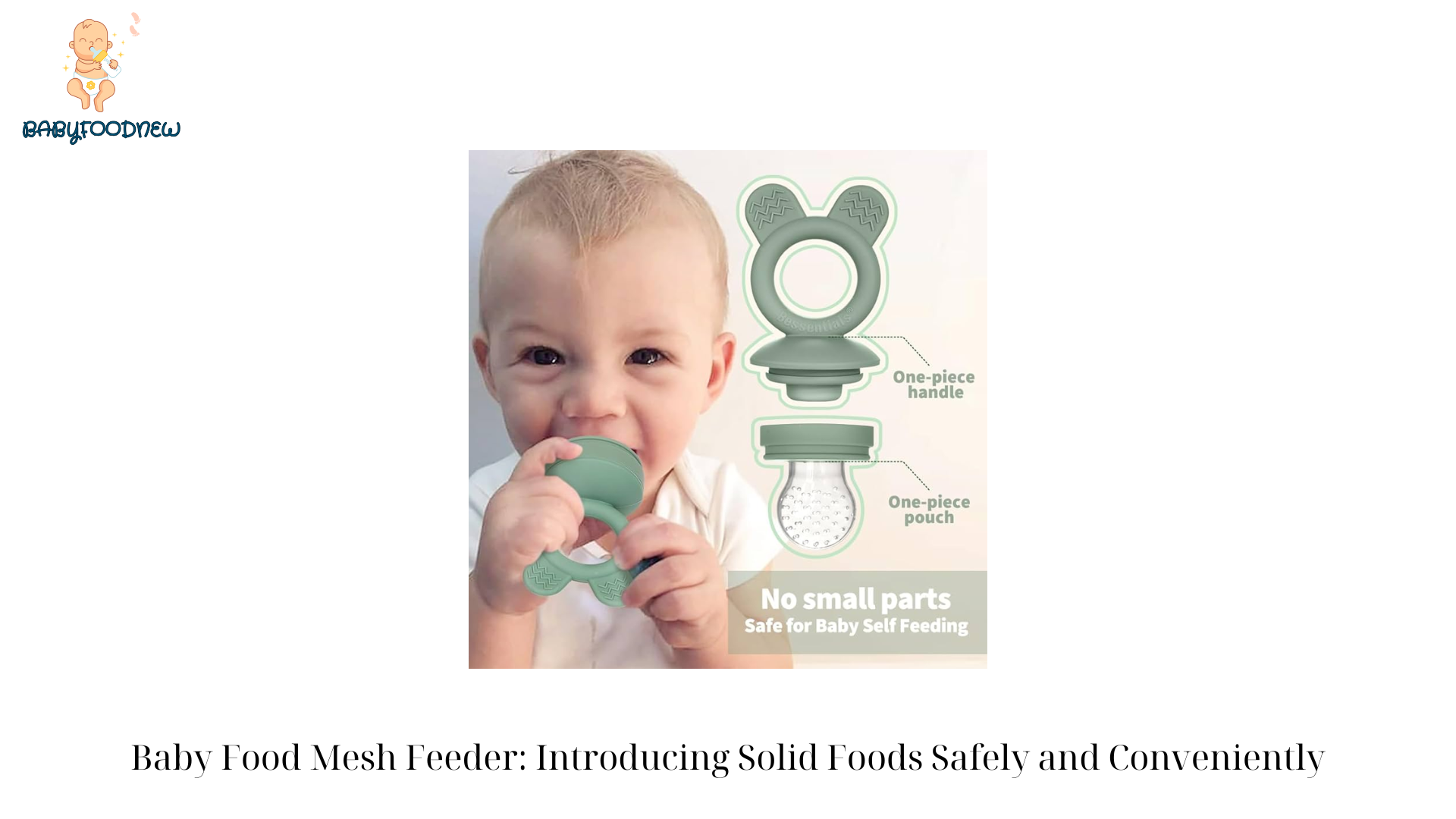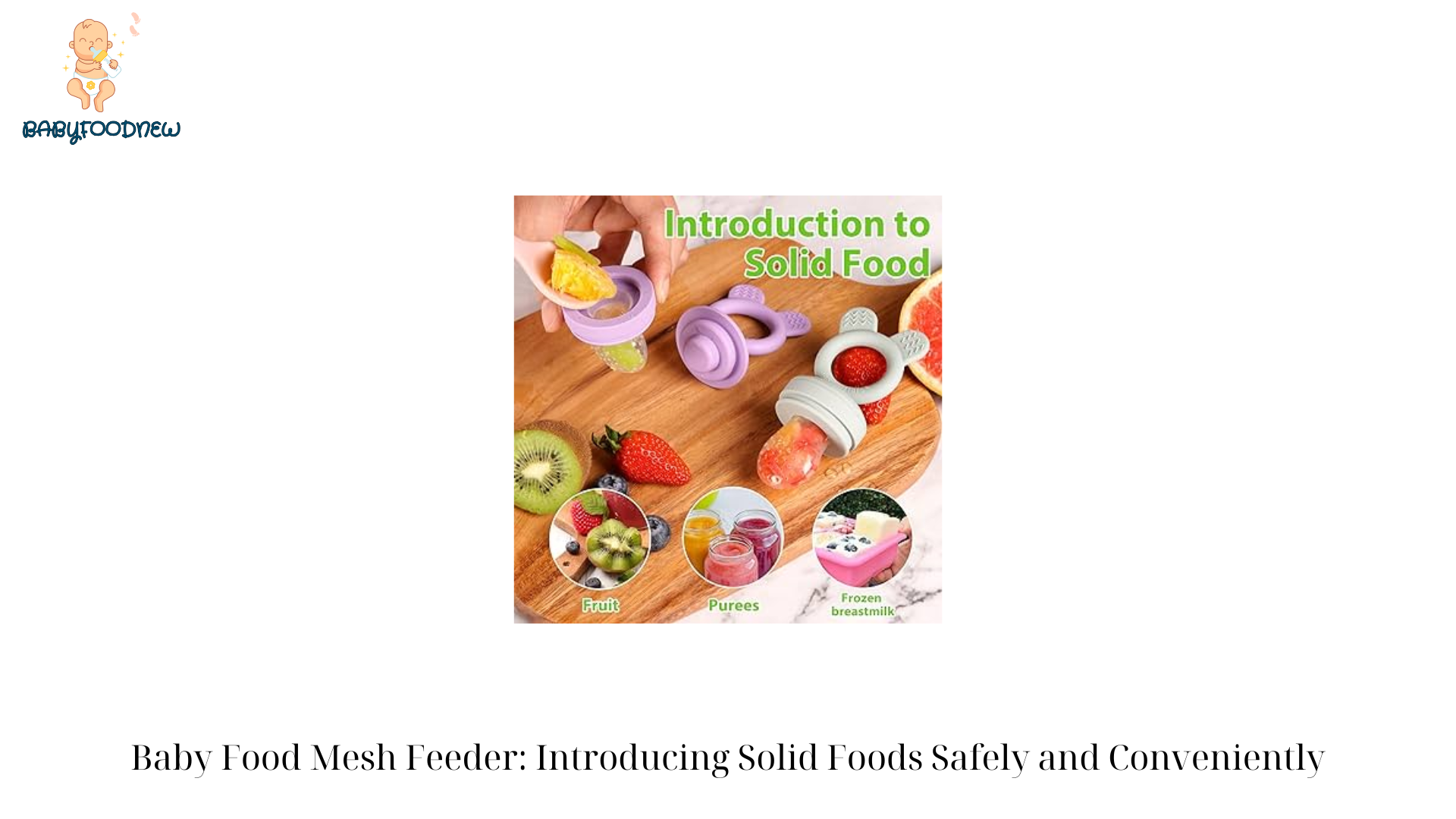Introducing solid foods to your baby is an exciting milestone in their development. As a parent, you want to ensure that this transition is safe, convenient, and enjoyable for both you and your little one. One tool that can assist you in this process is the baby food mesh feeder. In this article, Babyfoodnew will explore the benefits of using a baby food mesh feeder when introducing solid foods to your baby. We will discuss its safety features, convenience, and how it can help in promoting healthy eating habits.
Baby Food Mesh Feeder: Introducing Solid Foods Safely and Conveniently

What is a Baby Food Mesh Feeder?
A baby food mesh feeder is a small feeding tool designed specifically for infants who are starting to eat solid foods. It typically consists of a soft silicone or mesh pouch attached to a handle. The mesh pouch allows you to place small pieces of food inside, which your baby can then safely suck or chew on. The purpose of the mesh feeder is to introduce new flavors and textures to your baby while minimizing the risk of choking.
Safety Features of a Baby Food Mesh Feeder
When it comes to introducing solid foods to your baby, safety is of utmost importance. A baby food mesh feeder offers several safety features that make it a reliable tool for this purpose. The mesh pouch is designed with small holes that allow your baby to extract the food through sucking or chewing, while preventing larger pieces from entering their mouth. This reduces the risk of choking and ensures that your baby receives small, manageable portions of food.
Additionally, the handle of the baby food mesh feeder is designed with a comfortable grip, making it easy for your baby to hold and manipulate. The materials used in the construction of the mesh feeder are typically BPA-free and food-grade silicone or mesh, ensuring that it is safe for your baby to use.
Convenience of Using a Baby Food Mesh Feeder
Introducing solid foods to your baby can sometimes be a messy affair. However, a baby food mesh feeder can help in minimizing the mess and making the feeding process more convenient. The mesh pouch is easy to clean and can be detached from the handle for thorough washing. Many mesh feeders are also dishwasher-safe, which further simplifies the cleaning process.
The size and portability of a baby food mesh feeder make it a convenient tool for on-the-go feeding. Whether you are at home, visiting family, or dining out at a restaurant, you can easily pack the mesh feeder in your diaper bag and provide your baby with a safe and nutritious meal wherever you are.

Promoting Healthy Eating Habits
One of the advantages of using a baby food mesh feeder is that it promotes healthy eating habits from the start. By placing small pieces of food inside the mesh pouch, you can introduce a variety of flavors and textures to your baby. This helps in expanding their palate and exposing them to different types of food early on.
Furthermore, the process of sucking and chewing on the food through the mesh feeder encourages self-feeding and develops your baby’s fine motor skills. As they manipulate the handle and explore the different tastes and textures, they are also developing their hand-eye coordination, oral motor skills, and sensory awareness.
Choosing Suitable Foods for the Baby Food Mesh Feeder
When using a baby food mesh feeder, it is important to choose foods that are appropriate for your baby’s age and developmental stage. Soft and easily mashable foods are ideal for the mesh feeder. Here are some examples of suitable foods:
- Fresh fruits: Soft fruits like bananas, ripe mangoes, peaches, and avocados can be mashed or cut into small pieces for the mesh feeder.
- Cooked vegetables: Steamed or boiled vegetables such as sweet potatoes, carrots, peas, and broccoli can be mashed or cut into soft chunks.
- Soft meats: Cooked and finely shredded or minced meats like chicken, turkey, or beef can be introduced in small amounts.
- Cooked grains: Soft and well-cooked grains like rice, quinoa, or oatmeal can be mashed or cut into manageable portions.
- Soft cheeses: Small pieces of soft cheese like cheddar or mozzarella can be introduced for added variety.
It is important to remember that introducing new foods to your baby should be done gradually and one at a time. Watch for any signs of allergies or sensitivities and consult with your pediatrician if you have any concerns.
Cleaning and Maintenance
Proper cleaning and maintenance of the baby food mesh feeder are essential to ensure its longevity and hygiene. After each use, dismantle the mesh feeder and rinse it under warm water to remove any food residue. Use a mild soap and a soft brush to gently clean the mesh pouch, making sure to reach all the small holes. Thoroughly rinse off the soap and allow the parts to air dry.
Regularly inspect the mesh feeder for any signs of wear and tear. If you notice any tears or holes in the mesh pouch, it is advisable to replace it to maintain its safety and effectiveness.
Conclusion
Introducing solid foods to your baby is an important step in their developmentand growth. The baby food mesh feeder is a valuable tool that can make this transition safer, more convenient, and enjoyable for both you and your baby. With its safety features, ease of use, and ability to promote healthy eating habits, the mesh feeder becomes an essential item in your baby’s feeding journey.
By using a baby food mesh feeder, you can introduce a variety of flavors and textures to your baby while minimizing the risk of choking. Its small holes allow for the extraction of food through sucking or chewing, ensuring that your baby receives appropriate portions. The comfortable grip handle makes it easy for your baby to hold and manipulate the feeder, promoting self-feeding and developing their fine motor skills.
The convenience of the baby food mesh feeder extends beyond its safety features. Cleaning the mesh pouch is a breeze, and many mesh feeders are dishwasher-safe. Its compact size makes it perfect for travel, allowing you to provide your baby with a nutritious meal no matter where you are.
As you introduce new foods to your baby through the mesh feeder, you are laying the foundation for healthy eating habits. The exposure to different flavors and textures expands their palate and encourages a diverse diet. Additionally, the process of sucking and chewing on the food stimulates their oral motor skills, hand-eye coordination, and sensory awareness.

When choosing foods for the baby food mesh feeder, opt for soft and easily mashable options. Fresh fruits, cooked vegetables, soft meats, cooked grains, and soft cheeses are all suitable choices. Remember to introduce new foods gradually and observe your baby for any signs of allergies or sensitivities.
Proper cleaning and maintenance of the baby food mesh feeder are crucial. Disassemble the feeder and rinse it thoroughly after each use. Clean the mesh pouch with a mild soap and a soft brush, paying attention to the small holes. Regularly inspect the feeder for any signs of wear and tear, and replace the mesh pouch if necessary.
In conclusion, the baby food mesh feeder is an invaluable tool for introducing solid foods to your baby. Its safety features, convenience, and ability to promote healthy eating habits make it a must-have item for parents. As you embark on this exciting journey of feeding your baby, the mesh feeder will be there to support you every step of the way.
Related Posts:
- Baby Food Vegetables: A Nutritious Introduction to…
- Baby Food Ice Cube Tray: A Convenient Solution for…
- Lentil Baby Food Recipe: Nutritious and Delicious…
- Baby Bella Mushroom Nutrition: Unveiling the Health Benefits
- Can You Microwave Baby Food Safely? Exploring the Options
- Baby Nutrition at 6 Months: A Guide to Introducing…


